Archive:Asylum quarterly report
- Data extracted on 19 March 2018. Most recent data: Further Eurostat information, Main tables and Database. Planned update of the article: June 2018.
First time asylum applicants and first instance decisions on asylum applications: fourth quarter 2017
This article describes recent developments in relation to numbers of asylum applicants and first instance decisions on asylum applications in the European Union (EU). Asylum is a form of international protection given by a state on its territory. It is granted to a person who is unable to seek protection in his/her country of citizenship and/or residence, in particular for fear of being persecuted for reasons of race, religion, nationality, membership of a particular social group, or political opinion.
Key messages
- Almost 165 000 first time asylum seekers in the third quarter of 2017 - a number around the levels recorded in 2014, before the 2015 peaks
- Syrians and Iraqis were the most numerous asylum applicants in the EU Member States in the third quarter 2017
- Nearly half of all asylum seekers applied for asylum either in Germany or in Italy
- Highest number of first time applicants relative to the population in Cyprus and Greece
- Slow decrease in the number of asylum applications still pending at the end of the third quarter 2017
- 202 700 first instance decisions were made by the national authorities of EU Member States; among them, 43 % were positive
- Syrians received the highest number of decisions granting protection status in the EU Member States, followed by Afghans and Iraqis
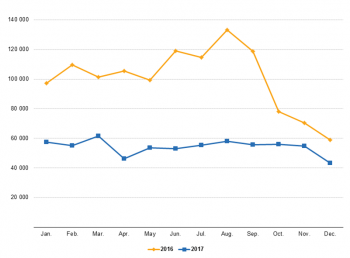
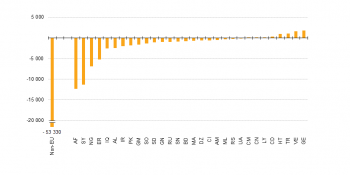
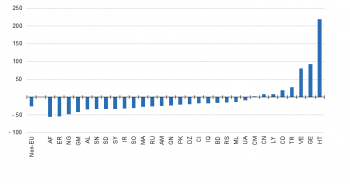
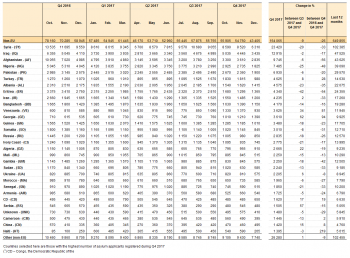
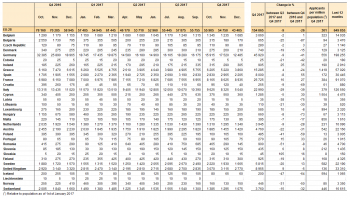
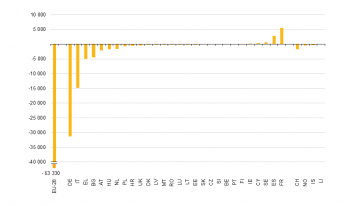
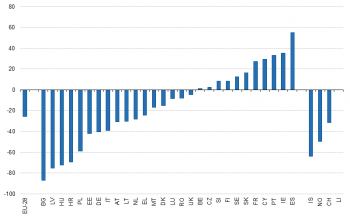

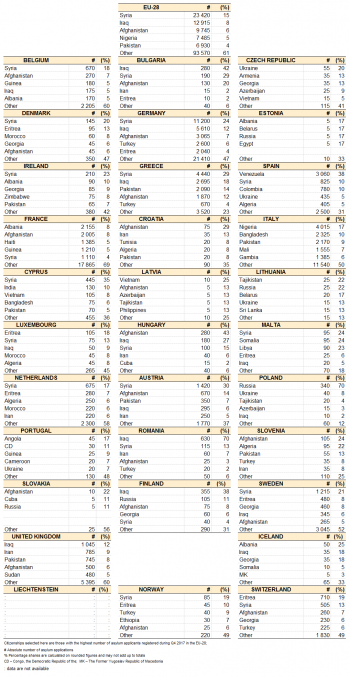
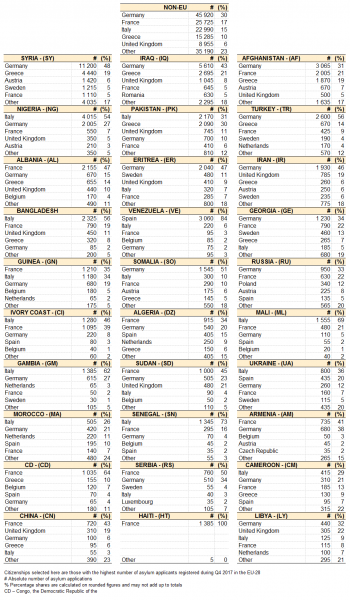
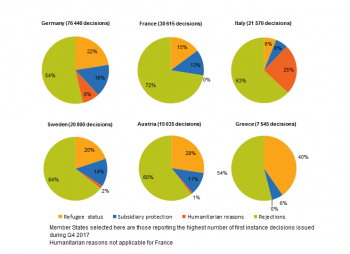
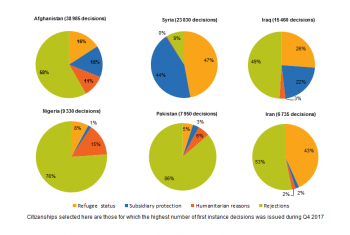


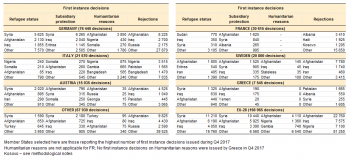
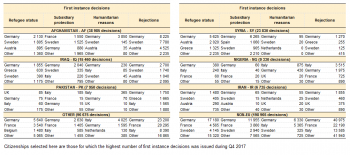
Main statistical findings
Main trends in the numbers of asylum applicants
The number of first time asylum applicants[1] in the EU-28 decreased by -55 % in the third quarter of 2017 compared with the same quarter of 2016, while it increased by 10 % compared with the second quarter of 2017. Overall, the number of persons seeking asylum from non-EU countries in the EU-28 during the third quarter of 2017 was 164 300, a number around the levels recorded in 2014, before the 2015 peaks (Table 1,Table 2). Out of the 177 000 total asylum applicants (i.e. including repeat applicants), 164 000 (93 %) were first time applicants (Table 2, Table 3).
Where do they come from?
Citizens of 146 countries sought asylum for the first time in the EU in the third quarter of 2017. Syrians, Iraqis and Afghans were the top 3 citizenships of asylum seekers, lodging 26 600, 12 500 and 9 900 applications respectively (Table 1).
Syrians (64 500 less applicants compared with the third quarter of 2016) contributed most to the overall decrease in first time asylum applicants in absolute terms, followed by Afghans (54 000 less) and Iraqis (25 200 less). In contrast, the number of asylum applicants increased most in absolute terms for citizens of Venezuela (1 500 more), Turkey (1 100 more) and Palestine (1 000 more) (Figure 2, Table 1).
The most substantial relative decrease of the number of asylum applicants in the EU in the third quarter of 2017 compared with the same quarter of 2016 recorded for Afghans (-80 % less), Syrians, Iranians and Iraqis (each dropped by around -70 % less). In contrast, Palestine (nearly 3 times more) and Venezuela (2 times more) were the countries of citizenships which mostly increased in relative terms in the third quarter of 2017, compared with the same quarter of 2016 (Figure 3, Table 1).
Of the 26 600 Syrians who applied for the first time for asylum in the EU in the third quarter of 2017 40 % were registered in Germany (11 000) and 16 % in Greece (4 200). Similarly, 44 % of Iraqis (5 500) and 34 % of Afghans (3 400) applied for asylum in Germany. Syrians were the main citizenship of asylum seekers in 12 EU Member States (Table 4, Table 5).
Main destination countries
The highest number of first time asylum applicants in the third quarter of 2017 was registered in Germany (with over 46 000 first time applicants, or 28 % of all applicants in the EU Member States), followed by Italy (32 500, or 20%), France (22 200, or 14%), Greece (14 600, or 9%) and Spain (8 700, or 5%). These 5 Member States together account for 76 % of all first time applicants in the EU-28 (Table 2).
Trends in number of asylum applicants vary from country to country in the third quarter of 2017. Germany (with -199 000 less applicants) was the country with the largest absolute decrease in the number of first time applicants. In contrast, in Spain the number of asylum seekers has increased by 5 200 more, in Greece by 2 200 and in France and Sweden by 2 000 more each in the third quarter of 2017 compared with the same quarter of 2016 (Figures 4 and 5).
In relative terms, Bulgaria, Hungary and Germany have recorded the largest relative decreases of first time asylum seekers (more than -80 % less each) in the third quarter of 2017 compared with the same quarter of 2016. In contrast, Romania has recorded the largest relative increase of first time asylum seekers (4 times more) in the third quarter of 2017 compared with the same quarter of 2016.
Compared with the population of each Member State, the highest rate of registered first time applicants during the third quarter of 2017 was recorded in Cyprus (1 577 first time applicants per million inhabitants) and Greece (1 361), followed by Malta (960) and Luxembourg (904). In contrast, the lowest rates were observed in Slovakia (4 applicants per million inhabitants), Poland (22), Portugal (23), Estonia (25), the Czech Republic (27) and Latvia (29). In the third quarter 2017, there were in total 321 first time asylum applicants per million inhabitants in the EU as a whole. (Table 2).
Decisions on asylum applications
202 700 first instance decisions[2] were made by the national authorities of EU Member States during the third quarter of 2017. Among them, 43 % were positive (i.e. granting a type of protection status) (Table 6).
Germany issued by far the most total first instance decisions[3] during the third quarter of 2017 (90 900 decisions), followed by France (30 500), Italy (18 600), Sweden (15 100), Austria (14 700) and Greece (6 800) (Figure 6, Table 6).
Most first instance decisions in the EU-28 were issued to Syrians (29 600), followed by Afghans (29 100) and Iraqis (17 400) (Table 7).
Syrians received the highest number of decisions granting protection status in the EU Member States, including protection based on national legislations (27 600 positive first instance decisions, or 93% rate of recognition[4]), followed by Afghans (14 000, or 48 %) and Iraqis (9 600, or 55 %).
In contrast, of the approximately 2 000 first instance decisions issued to citizens of the Former Yugoslav Republic of Macedonia only 30 were positive (or 2% rate of recognition), while of the 2 300 issued to Serbians only 60 were positive (or 3 %). Similarly, the rate of recognition was low for citizens of Haiti (3 %), Georgia (4 %) and Algeria (8 %) (Figure 7, Table 7).
Data sources and availability
The data used for this publication are provided to Eurostat by the Ministries of Interior, Justice or immigration agencies of the Member States and EFTA countries. Data on asylum applications are collected monthly while data on first instance decisions are collected quarterly. Data are based entirely on relevant administrative sources.
Apart from statistics on first asylum applicants, these data are supplied in accordance with the provisions of Article 4 of the Regulation (EC) No 862/2007 of 11 July 2007 on Community statistics on migration and international protection. All data presented in this publication are rounded to the nearest 5, and are provisional (except as otherwise stated) and may be a subject to change.
Context
The Directorate-General Migration and Home Affairs (DG HOME) is responsible for developing EU policies on asylum.
The 1951 Geneva Convention relating to the status of refugees (as amended by the 1967 New York Protocol) has, for over 60 years, defined who is a refugee, and laid down a common approach towards refugees that has been one of the cornerstones for the development of a common asylum system within the EU.
Since 1999, the EU has worked towards creating a common European asylum regime in accordance with the Geneva Convention and other applicable international instruments. A number of directives in this area have been developed. The four main legal instruments on asylum — all recently recast — are:
- the Qualification Directive 2011/95/EU on standards for the qualification of non-EU nationals and stateless persons as beneficiaries of international protection, for a uniform status for refugees or for persons eligible for subsidiary protection;
- the Asylum Procedures Directive 2013/32/EU on common procedures for granting and withdrawing international protection;
- the Reception Conditions Directive 2013/33/EU laying down standards for the reception of applicants for international protection;
- the Dublin Regulation (EU) No 604/2013 establishing the criteria and mechanisms for determining the Member State responsible for examining an application for international protection lodged in one of the Member States by a third-country national or stateless person.
The Hague programme was adopted by heads of state and government on 5 November 2004. It puts forward the idea of a common European asylum system (CEAS), in particular, it raises the challenge to establish common procedures and uniform status for those granted asylum or subsidiary protection. The European Commission’s policy plan on asylum (COM(2008) 360 final) was presented in June 2008 which included three pillars to underpin the development of the CEAS:
- bringing more harmonisation to standards of protection by further aligning the EU Member States’ asylum legislation;
- effective and well-supported practical cooperation;
- increased solidarity and sense of responsibility among EU Member States, and between the EU and non-member countries.
With this in mind, in 2009 the European Commission made a proposal to establish a European Asylum Support Office (EASO). The EASO supports EU Member States in their efforts to implement a more consistent and fair asylum policy. It also provides technical and operational support to EU Member States facing particular pressures (in other words, those EU Member States receiving large numbers of asylum applicants). The EASO became fully operational in June 2011 and has worked to increase its capacity, activity and influence, working with the European Commission and the United Nations High Commissioner for Refugees (UNHCR).
In May 2010, the European Commission presented an action plan for unaccompanied minors (COM(2010) 213 final), who are regarded as the most exposed and vulnerable victims of migration. This plan aims to set-up a coordinated approach and commits all EU Member States to grant high standards of reception, protection and integration for unaccompanied minors. As a complement to this action plan, the European Migration Network has produced a comprehensive EU study on reception policies, as well as return and integration arrangements for unaccompanied minors.
In December 2011, the European Commission adopted a Communication on ‘Enhanced intra-EU solidarity in the field of asylum’ (COM(2011) 835 final). This provided proposals to reinforce practical, technical and financial cooperation, moving towards a better allocation of responsibilities and improved governance of the asylum system in the EU, namely through:
- introducing an evaluation and early warning mechanism to detect and address emerging problems;
- making the supporting role of the EASO more effective;
- increasing the amount of funds available and making these more flexible, taking into account significant fluctuations in the number of asylum seekers;
- developing and encouraging the relocation of beneficiaries of international protection between different EU Member States.
See also
- Asylum statistics
- Dublin statistics on countries responsible for asylum application
- Statistics on enforcement of immigration legislation
- Residence permits statistics
Further Eurostat information
Publications
News releases
- 1.2 million first time asylum seekers registered in 2016
- Number of first time asylum seekers slightly up to almost 306 000 in the second quarter of 2016
- Number of first time asylum seekers down to fewer than 290 000 in the first quarter of 2016
- Record number of over 1.2 million first time asylum seekers registered in 2015
- More than 410 000 first time asylum seekers registered in the third quarter of 2015
- Over 210 000 first time asylum seekers in the EU in the second quarter of 2015
- 185 000 first time asylum seekers in the EU in the first quarter of 2015
Data in focus
- Asylum applicants and first instance decisions on asylum applications: 2014
- Asylum applicants and first instance decisions on asylum applications: third quarter 2014
- Asylum applicants and first instance decisions on asylum applications: second quarter 2014
- Asylum applicants and first instance decisions on asylum applications: first quarter 2014
- Asylum applicants and first instance decisions on asylum applications: 2013
- Asylum applicants and first instance decisions on asylum applications: third quarter 2013
- Asylum applicants and first instance decisions on asylum applications: second quarter 2013
- Asylum applicants and first instance decisions on asylum applications: first quarter 2013
- Asylum applicants and first instance decisions on asylum applications: 2012
- Asylum applicants and first instance decisions on asylum applications: third quarter 2012
- Asylum applicants and first instance decisions on asylum applications: second quarter 2012
- Asylum applicants and first instance decisions on asylum applications: first quarter 2012
Main tables
- Asylum and new asylum applicants - monthly data
- Persons subject of asylum applications pending at the end of the month - monthly data
- Asylum and new asylum applicants - annual aggregated data
- First instance decisions on applications by type of decision - annual aggregated data
- Final decisions on applications - annual data
- Asylum applicants considered to be unaccompanied minors - annual data
- Resettled persons - annual data
Database
- Applications (migr_asyapp)
- Asylum applicants by citizenship till 2007 Annual data (rounded) (migr_asyctz)
- First time asylum applicants by citizenship till December 2007 Monthly data (rounded) (migr_asyctzm)
- Asylum and first time asylum applicants by citizenship, age and sex Annual aggregated data (rounded) (migr_asyappctza)
- Asylum and first time asylum applicants by citizenship, age and sex Monthly data (rounded) (migr_asyappctzm)
- Persons subject of asylum applications pending at the end of the month by citizenship, age and sex - Monthly data (rounded) (migr_asypenctzm)
- Asylum applications withdrawn by citizenship, age and sex Annual aggregated data (rounded) (migr_asywitha)
- Asylum applications withdrawn by citizenship, age and sex - Monthly data (rounded) (migr_asywithm)
- Asylum applicants considered to be unaccompanied minors by citizenship, age and sex Annual data (rounded) (migr_asyunaa)
- Decisions on applications and resettlement (migr_asydec)
- Decisions on asylum applications by citizenship till 2007 Annual data (rounded) (migr_asydctzy)
- Decisions on asylum applications by citizenship till December 2007 Monthly data (rounded) (migr_asydctzm)
- First instance decisions on applications by citizenship, age and sex Annual aggregated data (rounded) (migr_asydcfsta)
- First instance decisions on applications by citizenship, age and sex Quarterly data (rounded) (migr_asydcftq)
- Decisions withdrawing status granted at first instance decision by type of status withdrawn and by citizenship Annual aggregated data (rounded) (migr_asywitfsta)
- Decisions withdrawing status granted at first instance decision by type of status withdrawn and by citizenship Quarterly data (rounded) (migr_asywitfstq)
- Final decisions on applications by citizenship, age and sex Annual data (rounded) (migr_asydcfina)
- Decisions withdrawing status granted as final decision by type of status withdrawn Annual data (rounded) (asywitfina)
- Resettled persons by age, sex and citizenship Annual data (rounded) (migr_asyresa)
- Applications (migr_asyapp)
Dedicated section
Methodology / Metadata
- Applications (migr_asyapp) (ESMS metadata file — migr_asyapp_esms)
- Decisions on applications and resettlement (migr_asydec) (ESMS metadata file — migr_asydec_esms)
External links
- European Commission - DG Migration and Home Affairs - Asylum
- European Asylum Support Office - EASO
- European Migration Network - EMN
- UNHCR - Statistics
Notes
- ↑ First time applicant for international protection is a person who lodged an application for asylum for the first time in a given Member State. The indicator 'First time asylum applicants' excludes repeat applicants i.e. persons applying for asylum more than once in one country and therefore more accurately presents the number of persons applying for international protection in the EU Member States. The use of this indicator is possible as all Member States are able to provide it to Eurostat since 2014.
- ↑ Data on first instance decisions relate to decisions on applications granted to all asylum applicants i.e. First time asylum applicants and Repeat asylum applicants.
- ↑ Total decisions equal to positive decisions plus negative decisions.
- ↑ Rate of recognition is the share of (first instance) positive decisions in the total number of decisions at first instance. In this report, the exact number of decisions has been used instead of the presented rounded numbers. Rates of recognition for humanitarian status are not shown, but are part of the 'Total recognition rate'.